Energy Burden in the United States: An Analysis Using Decision Trees
Abstract
1. Introduction
2. Literature Review
2.1. Energy Burden as an Emerging Concept
2.2. Measurement Challenges and Advancements
2.2.1. Metrics
2.2.2. Data Advancements
2.3. Energy Burden and Associated Factors
2.3.1. Weather Conditions
2.3.2. Built and Digital Infrastructure
2.3.3. Socioeconomic Conditions
2.3.4. Racial Demographics
3. Materials and Methods—Decision Tree (DT) Concepts and Principles
3.1. Data Collection
- The places that did not have energy burden level information were deleted.
- Standardization of categories: Variables that can be broken down under the same category were grouped.
- Normalization: To compare the places with significant differences in size and population, the absolute numbers were transformed into percentages within their category.
3.2. Data Analysis
3.2.1. DT Model Development
Dependent Variable: Energy Burden
- The energy burden values extracted from the Low-Income Energy Affordability Data (LEAD) Tool were classified into three distinct categories, as shown in Table 2: Class A—Low Energy Burden: Households with less than 4% energy burden. These households allocate a relatively small portion of their income to energy costs, suggesting better energy affordability.
- Class B—Medium Energy Burden: Households that spend more than 4% but less than 6%. This range indicates a moderate level of energy spending, raising the need for cautious energy management.
- Class C—High Energy Burden: Households with an energy burden greater than 6%. This group faces significant energy affordability challenges, dedicating a substantial portion of their income to energy costs, which can impact other areas of household spending and financial stability.
| Class | Count (Places) | Percentage |
|---|---|---|
| A—Low Energy Burden (less than 4%) | 3038 | 16.2% |
| B—Medium Energy Burden (between 4 and 6%) | 8765 | 46.7% |
| C—High Energy Burden (more than 6%) | 6983 | 37.2% |
| Total | 18,786 | 100% |
- Demographics: captures characteristics of the household occupants.
- Labor Conditions: focuses on factors related to employment status and industry.
- Geography: considers the physical characteristics of the locations.
- Climate: local climate characteristics are captured in this category.
- Housing: explores characteristics of the dwelling unit itself.
- Housing Utilities: focuses on the specific utilities used within the dwelling.
- Other Place Characteristics: captures additional factors specific to the places.
- State Energy Profile: considers the state’s energy-related characteristics.
3.2.2. DT Model Features
3.2.3. Evaluation Metrics
4. Results
4.1. DT Analysis Outcomes
4.2. Key Variable Mapping and Analysis
5. Discussion
5.1. Cross-Sectoral Relationships and Impact
5.2. Rural and Urban Dynamics
5.3. Policy Implications
5.4. Limitations and Future Direction
6. Conclusions
Author Contributions
Funding
Data Availability Statement
Conflicts of Interest
Appendix A
| 1. Demographics | |||
|---|---|---|---|
| Category | Variable Name | Description | Units |
| total_pop | Total population of the town or municipality [31] | Inhabitants | |
| pop_over_25 | Total population over 25 years old [31] | Inhabitants | |
| Race | Breakdown by ethnicity group [31] | Percentage (%) | |
| · race_black | Black population | ||
| · race_native_ak | Native American or Alaskan population | ||
| · race_white | White population | ||
| · race_asian | Asian population | ||
| · race_hi_pacific | Hawaiian Pacific Islander population | ||
| · race_other | Other race population | ||
| · race_mixed | Mixed race population | ||
| Age | Elderliness [31] | Percentage (%) | |
| · age_under_5 | Population under 5 years old | ||
| · age_5_9 | Population between 5 and 9 years old | ||
| · age_10_14 | Population between 10 and 14 years old | ||
| · age_15_17 | Population between 15 and 17 years old | ||
| · age_18_24 | Population between 18 and 24 years old | ||
| · age_25_34 | Population between 25 and 34 years old | ||
| · age_35_44 | Population between 35 and 44 years old | ||
| · age_45_54 | Population between 45 and 54 years old | ||
| · age_55_64 | Population between 55 and 64 years old | ||
| · age_65_74 | Population between 65 and 74 years old | ||
| · age_75_84 | Population between 75 and 84 years old | ||
| · age_85_plus | Population 85 years old and over | ||
| Gender | Sex assigned at birth [31] | Percentage (%) | |
| · gender_male | Male population | ||
| · gender_female | Female population | ||
| Educational Attainment | Level of education [31] | Percentage (%) | |
| · less_than_hs_edu | Population over 25 with less than high school education | ||
| · highschool_edu | Population over 25 with high school education as maximum studies | ||
| · some_college_edu | Population over 25 with college education as maximum studies | ||
| · bachelors_edu | Population over 25 with undergraduate degree as maximum studies | ||
| · masters_edu | Population over 25 with a masters degree | ||
| · professional_edu | Population over 25 with a professional degree (doctor, lawyers, etc.) | ||
| · doctorate_edu | Population over 25 with a doctorate degree | ||
| 2. Labor condition | |||
| Category | Variable Name | Description | Units |
| Military/Civilian Population | Total workers | Total workforce (military and civilian) [31] | Inhabitants |
| Breakdown of population by military-relationship [64] | Percentage (%) | ||
| · army_pop | Number of people in the army | ||
| · civilian_pop | Number of civilians | ||
| Labor Force Breakdown | Breakdown of population by their working status [31] | Percentage (%) | |
| · employed | Number of employed civilians | ||
| · unemployed | Number of unemployed civilians | ||
| Job Industry | Breakdown of employed civilians by industry [31] | Percentage (%) | |
| · agriculture | Employed in agriculture | ||
| · construction | Employed in construction | ||
| · manufacturing | Employed in manufacturing | ||
| · wholesale | Employed in wholesale trade | ||
| · retail | Employed in retail trade | ||
| · transit_utilities | Employed in transportation and utilities | ||
| · information | Employed in information sector | ||
| · finance_insurance | Employed in finance and insurance | ||
| · scientific | Employed in scientific and professional services | ||
| · education | Employed in education | ||
| · art_entertainment | Employed in arts, entertainment, and recreation | ||
| · other | Employed in other services | ||
| · public_administration | Employed in public administration | ||
| 3. Geography | |||
| Category | Variable Name | Description | Units |
| pop dens | People divided by the place area [31] | Persons per square mile | |
| area sq mi | Total number of square miles that make up a place [31] | Square miles | |
| land cover median | median land cover value of a place [65] | Value | |
| land cover maximum | median land cover value of a place [65] | Value | |
| land cover minimum | median land cover value of a place [65] | Value | |
| 4. Climate | |||
| Category | Variable Name | Description | Units |
| median_precipitation | Median precipitation of a place in a year-period [66] | Inches per year | |
| median_wind_speed | Median value of the wind speed in a place [64] | Meters per second | |
| median_temperature | Median temperature of a place [66] | Celsius | |
| 5.Housing | |||
| Category | Variable Name | Description | Units |
| Structure type | Breakdown of housing units by structure type [31] | Percentage (%) | |
| · structure_one_unit | Single detached unit | ||
| · structure_one_unit_attached | Single attached unit (townhouse, condo) | ||
| · structure_two_unit | Building with two dwelling units | ||
| · structure_three_four_unit | Building with three or four dwelling units | ||
| · structure_five_nine_unit | Building with five to nine dwelling units | ||
| · structure_ten_nineteen_unit | Building with ten to nineteen dwelling units | ||
| · structure_twenty_forty_nine_unit | Building with twenty to forty-nine dwelling units | ||
| · structure_fifty_plus_unit | Building with fifty or more dwelling units | ||
| · structure_mobile_home | Mobile home | ||
| · structure_other | Other housing structure (boat, RV, van, etc.) | ||
| People per room | Breawdown by number of people there are per room in a unit [4] | Percentage (%) | |
| · occupants per room less than 0.5 | Less than 0.5 people per room | ||
| · occupants per room 0.51 to 1.00 | 0.51 to 1.0 people per room | ||
| · occupants per room 1.01 to 1.50 | 1.01 to 1.5 people per room | ||
| · occupants per room 1.51 to 2.00 | 1.51 to 2.0 people per room | ||
| · occupants per room 2.01 or more | More than 2.0 people per room | ||
| Occupants per household | Breawdown by number of people there are per household (Family size) [31] | Percentage (%) | |
| · one person household | Households with 1 person | ||
| · two person household | Households with 2 people | ||
| · three person household | Households with 3 people | ||
| · four person household | Households with 4 people | ||
| · five person household | Households with 5 people | ||
| · six person household | Households with 6 people | ||
| · seven plus person household | Households with 7 or more people | ||
| Number of Rooms | Breakdown by number of rooms per unit [31] | Percentage (%) | |
| · one room units | Units with only one habitable room | ||
| · two room units | Units with two habitable rooms | ||
| · three room units | Units with three habitable rooms | ||
| · four room units | Units with four habitable rooms | ||
| · five room units | Units with five habitable rooms | ||
| · six room units | Units with six habitable rooms | ||
| · seven room units | Units with seven habitable rooms | ||
| · eight room units | Units with eight habitable rooms | ||
| · nine plus room units | Units with nine or more habitable rooms | ||
| Renters pers room | Breakdown by number of people there are per room in a rented unit [31] | Percentage (%) | |
| · renters per room less than 0.5 | Less than 0.5 renters per room | ||
| · renters per room 0.51 to 1.00 | 0.51 to 1.0 renters per room | ||
| · renters per room 1.01 to 1.50 | 1.01 to 1.5 renters per room | ||
| · renters per room 1.51 to 2.00 | 1.51 to 2.0 renters per room | ||
| · renters per room 2.01 or more | More than 2.0 renters per room | ||
| Head of Household Education Level | Breakdown by education level of the head of a rented house [31] | Percentage (%) | |
| · renter education less than hs | Head of house has less than a high school diploma | ||
| · renter education hs grad | Head of house has a high school diploma | ||
| · renter education some college | Head of house has some college education but no degree | ||
| · renter education bachelors plus | Head of house has a bachelor’s degree or higher | ||
| Vehicles per Renting Household | Breakdown by vehicles per renting house [31] | Percentage (%) | |
| · no vehicle house | No vehicles owned | ||
| · 1 vehicle house | One vehicle owned | ||
| · 2 vehicle house | Two vehicles owned | ||
| · 3 vehicle house | Three vehicles owned | ||
| · 4 vehicle house | Four vehicles owned | ||
| · 5 vehicle house | Five or more vehicles owned | ||
| 6. Housing Utilities | |||
| Category | Variable Name | Description | Units |
| Internet availability | internet in household | Total Households with internet [31] | Percentage (%) |
| Breakdown of internet availability in households | |||
| · no_subscription | Households with no internet subscription | ||
| · no_internet | Households with no internet subscription and no internet access | ||
| · internet_subscription | Households with internet subscription | ||
| Internet type | Breakdown of internet availability in households [31] | Percentage (%) | |
| · broadband_subscription_only | Households with only broadband internet | ||
| · dial_up_subscription | Households with only dial up internet | ||
| · satellite_subscription_only | Households with only satellite internet | ||
| · other_subscription | Households with other internet subscription type | ||
| · has computer | Total respondents with computer | ||
| Computer & Internet | Breakdown of computer ownership with internet access [31] | Percentage (%) | |
| · computer_dial_up | Households with computer and dial-up internet | ||
| · computer_broadband | Households with computer and broadband internet | ||
| · computer_no_subscription | Households with computer but no internet at all | ||
| · computer_no_internet | Households with computer but no internet subscription | ||
| Plumbing Status | Plumbing services in a house [31] | Percentage (%) | |
| · plumbing all complete | Housing units with complete plumbing | ||
| · plumbing all incomplete | Housing units with incomplete plumbing | ||
| Kitchen Status | Kitchen services in a house [31] | Percentage (%) | |
| · kitchen all complete | Housing units with complete kitchens | ||
| · kitchen all incomplete | Housing units with incomplete kitchens | ||
| Fuel Type | Breakdown of occupied housing units by fuel type [31] | Percentage (%) | |
| · occupied housing units tank | Uses tanked gas for electricity | ||
| · occupied housing units gas | Uses natural gas for electricity | ||
| · occupied housing units elec | Uses electric grid for electricity | ||
| · occupied housing units fuel | Uses fuel oil or kerosene for electricity (rare) | ||
| · occupied housing units coal | Uses coal for electricity (rare) | ||
| · occupied housing units wood | Uses wood for electricity (rare) | ||
| · occupied housing units solar | Uses solar power for electricity | ||
| · occupied housing units none | Does not use fuel | ||
| · occupied housing units other | Uses other source for electricity | ||
| Breakdown of housing units by fuel type [31] | Percentage (%) | ||
| · renter occupied housing units tank | Uses tanked gas for electricity | ||
| · renter occupied housing units gas | Uses natural gas for electricity | ||
| · renter occupied housing units elec | Uses electric grid for electricity | ||
| · renter occupied housing units fuel | Uses fuel oil or kerosene for electricity (rare) | ||
| · renter occupied housing units coal | Uses coal for electricity (rare) | ||
| · renter occupied housing units wood | Uses wood for electricity (rare) | ||
| · renter occupied housing units solar | Uses solar power for electricity | ||
| · renter occupied housing units none | Does not use fuel | ||
| · renter occupied housing units other | Uses other source for electricity | ||
| Breakdown of housing units by fuel type [31] | Percentage (%) | ||
| · heating_utility_bottled | Uses tanked gas for heating | ||
| · heating_utility_gas | Uses natural gas for heating | ||
| · heating_utility_electric | Uses electric grid for heating | ||
| · heating_utility_fuel | Uses fuel oil or kerosene for heating | ||
| · heating_utility_coal | Uses coal for heating | ||
| · heating_utility_wood | Uses wood for heating | ||
| · heating_utility_solar | Uses solar power for heating | ||
| · heating_utility_no_electricity | Heating utility no fuel | ||
| · heating_utility_other | Uses other source for heating | ||
| Telephone Renting Households | Telephone Service iavailability in Renting Households [31] | Percentage (%) | |
| · telephone service yes | Has telephone service available | ||
| · telephone service no | Does not have telephone service available | ||
| Telephone non-renting households | Telephone Service iavailability in non-renting Households [31] | Percentage (%) | |
| · telephone service yes | Household has telephone service available | ||
| · telephone service no | Household does not have telephone service available | ||
| 7. Other Place Characteristics | |||
| Category | Variable Name | Description | Units |
| Total households | Total number of households [31] | Percentage (%) | |
| Occupied housing_units | Total number of housing units [31] | Percentage (%) | |
| Renter Households | Total number of renter occupied Housing Unites [31] | (# of households) | |
| Median Year Built | Average construction age of buildings [31] | (Year) | |
| Housing Age Distribution | Breakdown by Housing Age [31] | Percentage (%) | |
| · built 2014 plus | Built in 2014 or later | ||
| · built 2010 to 2019 (2021 data only) | Built between 2010 and 2019 | ||
| · built 2010 to 2013 | Built between 2010 and 2013 | ||
| · built 2000 to 2009 | Built between 2000 and 2009 | ||
| · built 1990 to 1999 | Built between 1990 and 1999 | ||
| · built 1980 to 1989 | Built between 1980 and 1989 | ||
| · built 1970 to 1979 | Built between 1970 and 1979 | ||
| · built 1960 to 1969 | Built between 1960 and 1969 | ||
| · built 1950 to 1959 | Built between 1950 and 1959 | ||
| · built 1940 to 1949 | Built between 1940 and 1949 | ||
| · built 1939 or earlier | Built in 1939 or earlier | ||
| Breakdown by Housing Age [31] | |||
| · renter built 2014 plus | Built in 2014 or later | ||
| · renter built 2010 to 2019 | Built between 2010 and 2019 | ||
| · renter built 2010 to 2013 | Built between 2010 and 2013 | ||
| · renter built 2000 to 2009 | Built between 2000 and 2009 | ||
| · renter built 1990 to 1999 | Built between 1990 and 1999 | ||
| · renter built 1980 to 1989 | Built between 1980 and 1989 | ||
| · renter built 1970 to 1979 | Built between 1970 and 1979 | ||
| · renter built 1960 to 1969 | Built between 1960 and 1969 | ||
| · renter built 1950 to 1959 | Built between 1950 and 1959 | ||
| · renter built 1940 to 1949 | Built between 1940 and 1949 | ||
| · renter built 1939 or earlier | Built in 1939 or earlier | ||
| Renters by Commute Method | Breakdown by renters commute method [31] | Percentage (%) | |
| · renting commuter car alone | Renters who drive alone to work | ||
| · renting commuter carpool | Renters who carpool to work | ||
| · renting commuter public transit | Renters who use public transportation (excluding taxi) | ||
| · renting commuter walk | Renters who walk to work | ||
| · renting commuter other | Renters who use other means (taxi, bike, motorcycle) | ||
| · renting commuter wfh | Renters who work from home daily | ||
| 8. State Energy Profile | |||
| Category | Variable Name | Description | Units |
| Average Retail Price | Average price per kilowatt hour for electricity [67] | Dollars cents/kWh | |
| Net Summer Capacity | Highest power output available during peak season (June-Sept) [67] | Megawatts (MW) | |
| Net Generation | Total amount of electricity generated and delivered [67] | Megawatt-hours (MWh) | |
| Natural Gas Price | Average price of natural gas sold during the year [67] | Dollars per thousand cubic feet (Dths) | |
Appendix B
| Final Node | Classification Rules |
|---|---|
| Node 1. | IF (HasComputer <= 82.72) AND (NoInternet <= 22.71) AND (BachelorsEdu <= 19.60) AND (TotalPop =< 1977.5) AND (HasComputer <= 70.78) AND (OnePersonHousehold <= 33.3) AND (BachelorsEdu <= 11.13) THEN A = 2.40%, B = 41.30%, C = 56.30%. |
| Node 2. | IF (HasComputer <= 82.72) AND (NoInternet <= 22.71) AND (BachelorsEdu <= 19.60) AND (TotalPop =< 1977.5) AND (HasComputer <= 70.78) AND (OnePersonHousehold <= 33.3) AND (BachelorsEdu => 11.13) THEN A = 3%, B = 60%, C = 37%. |
| Node 3. | IF (HasComputer <= 82.72) AND (NoInternet <= 22.71) AND (BachelorsEdu <= 19.60) AND (TotalPop =< 1977.5) AND (HasComputer <= 70.78) AND (OnePersonHousehold => 33.3) THEN A = 2.1%, B = 29%, C = 68.9%. |
| Node 4. | IF (HasComputer <= 82.72) AND (NoInternet <= 22.71) AND (BachelorsEdu <= 19.60) AND (TotalPop =< 1977.5) AND (HasComputer => 70.78) AND (BachelorsEdu <= 9.23) AND (HeatingUtilityBottled <= 27.57) AND (OnePersonHousehold <= 29.24) THEN A = 1.40%, B = 62.40%, C = 36.2%. |
| Node 5. | IF (HasComputer <= 82.72) AND (NoInternet <= 22.71) AND (BachelorsEdu <= 19.60) AND (TotalPop =< 1977.5) AND (HasComputer => 70.78) AND (BachelorsEdu <= 9.23) AND (HeatingUtilityBottled <= 27.57) AND (OnePersonHousehold =>29.24) THEN A = 1.60%, B = 44.2%, C = 54.2%. |
| Node 6. | IF (HasComputer <= 82.72) AND (NoInternet <= 22.71) AND (BachelorsEdu <= 19.60) AND (TotalPop =< 1977.5) AND (HasComputer => 70.78) AND (BachelorsEdu <= 9.23) AND (HeatingUtilityBottled =>27.57) THEN A = 1.80%, B = 31.6%, C = 66.6%. |
| Node 7. | IF (HasComputer <= 82.72) AND (NoInternet <= 22.71) AND (BachelorsEdu <= 19.60) AND (TotalPop =< 1977.5) AND (HasComputer => 70.78) AND (BachelorsEdu => 9.23) THEN A = 3.60%, B = 68.2%, C = 28.2%. |
| Node 8. | IF (HasComputer <= 82.72) AND (NoInternet <= 22.71) AND (BachelorsEdu <= 19.60) AND (TotalPop => 1977.5) THEN A = 6%, B = 78.8%, C = 15.2%. |
| Node 9. | IF (HasComputer <= 82.72) AND (NoInternet <= 22.71) AND (BachelorsEdu => 19.60) AND (NoInternet <= 11.91) AND (HasComputer <= 39.50) THEN A = 8.50%, B = 59.4%, C = 32.1%. |
| Node 10. | IF (HasComputer <= 82.72) AND (NoInternet <= 22.71) AND (BachelorsEdu => 19.60) AND (NoInternet <= 11.91) AND (HasComputer => 39.50) THEN A = 44.8%, B = 47.8%, C = 7.4%. |
| Node 11. | IF (HasComputer <= 82.72) AND (NoInternet <= 22.71) AND (BachelorsEdu => 19.60) AND (NoInternet <= 11.91) AND (Asian <= 5.85) THEN A = 11.6%, B = 69.2%, C = 19.2%. |
| Node 12. | IF (HasComputer <= 82.72) AND (NoInternet <= 22.71) AND (BachelorsEdu => 19.60) AND (NoInternet <= 11.91) AND (Asian => 5.85) THEN A = 58.5%, B = 36.5%, C = 5%. |
| Node 13. | IF (HasComputer <= 82.72) AND (NoInternet => 22.71) AND (HasComputer <= 65.76) THEN A = 0.7%, B = 20.40%, C = 78.9%. |
| Node 14. | IF (HasComputer <= 82.72) AND (NoInternet => 22.71) AND (HasComputer <= 65.76) THEN A = 0.7%, B = 20.40%, C = 78.9%. |
| Node 15. | IF (HasComputer <= 82.72) AND (NoInternet => 22.71) AND (HasComputer => 65.76) AND (Households <= 535) THEN A = 0.9%, B = 38.9%, C = 60.2%. |
| Node 16. | IF (HasComputer <= 82.72) AND (NoInternet => 22.71) AND (HasComputer => 65.76) AND (Households => 535) AND (Black <= 31.83) AND (LaborForce <= 67.98) AND (Households <= 1735.5) THEN A = 0%, B = 45%, C = 55%. |
| Node 17. | IF (HasComputer <= 82.72) AND (NoInternet => 22.71) AND (HasComputer => 65.76) AND (Households => 535) AND (Black <= 31.83) AND (LaborForce => 67.98) THEN A = 2.7%, B = 74.6%, C = 22.7%. |
| Node 18. | IF (HasComputer <= 82.72) AND (NoInternet => 22.71) AND (HasComputer => 65.76) AND (Households => 535) AND (Black => 31.83) THEN A = 0%, B = 33%, C = 67%. |
| Node 19. | IF (HasComputer => 82.72) AND (Highschool Edu <= 30.75) THEN A = 70.6%, B = 27.7%, C = 1.7%. |
| Node 20. | IF (HasComputer => 82.72) AND (Highschool Edu => 30.75) AND (Built1939earlier <= 20.89) AND (NaturalGasPrice <= 8.75) THEN A = 36.2%, B = 57.40%, C = 6.4%. |
| Node 21. | IF (HasComputer => 82.72) AND (Highschool Edu => 30.75) AND (Built1939earlier <= 20.89) AND (NaturalGasPrice => 8.75) AND (HasComputer <= 87.16) THEN A = 11.4%, B = 80.7%, C = 7.9%. |
| Node 22. | IF (HasComputer => 82.72) AND (Highschool Edu => 30.75) AND (Built1939earlier <= 20.89) AND (NaturalGasPrice => 8.75) AND (HasComputer => 87.16) THEN A = 39.6%, B = 58.3%, C = 2.1%. |
| Node 23 | IF (HasComputer => 82.72) AND (Highschool Edu => 30.75) AND (Built1939earlier => 20.89) AND THEN A = 6.6%, B = 71.2%, C = 22.2%. |
References
- Low-Income Energy Affordability Data (LEAD) Tool and Community Energy Solutions. Available online: https://www.energy.gov/scep/low-income-energy-affordability-data-lead-tool-and-community-energy-solutions (accessed on 1 January 2025).
- Hirst, E.; Brown, M. Closing the efficiency gap: Barriers to the efficient use of energy. Resour. Conserv. Recycl. 1990, 3, 267–281. [Google Scholar] [CrossRef]
- HEECI Low. Lifting the High Energy Burden in America’s Largest Cities. 2016. Available online: https://www.ilsag.info/wp-content/uploads/SAG_files/Meeting_Materials/2017/January_31_2017/Lifting_High_Energy_Burden_Energy_Efficiency_for_All_ACEEE_April_2016.pdf (accessed on 14 January 2025).
- Blumstein, C.; Krieg, B.; Schipper, L.; York, C. Overcoming social and institutional barriers to energy conservation. Energy 1980, 5, 355–371. [Google Scholar] [CrossRef]
- Higgins, L.; Lutzenhiser, L. Ceremonial Equity: Low-Income Energy Assistance and the Failure of Socio-Environmental Policy. Soc. Probl. 1995, 42, 468–492. [Google Scholar] [CrossRef]
- Jones, E.C., Jr.; Reyes, A. Identifying Themes in Energy Poverty Research: Energy Justice Implications for Policy, Programs, and the Clean Energy Transition. Energies 2023, 16, 6698. [Google Scholar] [CrossRef]
- Belaïd, F. Implications of poorly designed climate policy on energy poverty: Global reflections on the current surge in energy prices. Energy Res. Soc. Sci. 2022, 92, 102790. [Google Scholar] [CrossRef]
- Carley, S.; Konisky, D.M. The justice and equity implications of the clean energy transition. Nat. Energy 2020, 5, 569–577. [Google Scholar] [CrossRef]
- Frondel, M.; Sommer, S.; Vance, C. The burden of Germany’s energy transition: An empirical analysis of distributional effects. Econ. Anal. Policy 2015, 45, 89–99. [Google Scholar] [CrossRef]
- Santamouris, M.; Kolokotsa, D. On the impact of urban overheating and extreme climatic conditions on housing, energy, comfort and environmental quality of vulnerable population in Europe. Energy Build. 2015, 98, 125–133. [Google Scholar] [CrossRef]
- Gillingham, K.; Kotchen, M.J.; Rapson, D.; Wagner, G. The rebound effect and energy efficiency policy. Rev. Environ. Econ. Policy 2016, 10, 68–88. [Google Scholar] [CrossRef]
- Pulido, L. Flint, environmental racism, and racial capitalism. Capital. Nat. Social. 2016, 27, 1–16. [Google Scholar] [CrossRef]
- Cyrek, M.; Cyrek, P.; Bieńkowska-Gołasa, W.; Gołasa, P. The Convergence of Energy Poverty across Countries in the European Union. Energies 2024, 17, 4957. [Google Scholar] [CrossRef]
- Brown, M.A.; Soni, A.; Lapsa, M.V.; Southworth, K.; Cox, M. Low-income energy affordability in an era of U.S. energy abundance. Prog. Energy 2020, 2, 042003. [Google Scholar] [CrossRef]
- Cong, S.; Nock, D.; Qiu, Y.L.; Xing, B. Unveiling hidden energy poverty using the energy equity gap. Nat. Commun. 2022, 13, 2456. [Google Scholar] [CrossRef] [PubMed]
- Sokolowski, J.; Lewandowski, P.; Kielczewska, A.; Bouzarovski, S. A multidimensional index to measure energy poverty: The Polish case. Energy Sources Part B Econ. Plan. Policy 2020, 15, 92–112. [Google Scholar] [CrossRef]
- Yang, S.; Fang, J.; Zhang, Z.; Lv, S.; Lin, H.; Ju, L. Two-stage coordinated optimal dispatching model and benefit allocation strategy for rural new energy microgrid. Energy 2024, 292, 130274. [Google Scholar] [CrossRef]
- Energy Poverty Advisory Hub (EPAH) Handbook 1: A Guide to Energy Poverty Diagnosis. Available online: https://energy-poverty.ec.europa.eu/system/files/2024-05/EPAHhandbook_diagnosis_finalpdf.pdf (accessed on 1 January 2025).
- Faiella, I.; Lavecchia, L. Energy poverty: How can you fight it if you can’t measure it? Energy Build. 2021, 233, 110692. [Google Scholar] [CrossRef]
- Bednar, D.J.; Reames, T.G. Recognition of and response to energy poverty in the United States. Nat. Energy 2020, 5, 432–439. [Google Scholar] [CrossRef]
- Grzybowska, U.; Wojewódzka-Wiewiórska, A.; Vaznonienė, G.; Dudek, H. Households Vulnerable to Energy Poverty in the Visegrad Group Countries: An Analysis of Socio-Economic Factors Using a Machine Learning Approach. Energies 2024, 17, 6310. [Google Scholar] [CrossRef]
- Maxim, A.; Grubert, E. Anticipating climate-related changes to residential energy burden in the United States: Advance planning for equity and resilience. Environ. Justice 2022, 15, 139–148. [Google Scholar] [CrossRef]
- Archer, C.L.; Jacobson, M.Z. Evaluation of global wind power. J. Geophys. Res. Atmos. 2005, 110, 1–20. [Google Scholar] [CrossRef]
- Wind Energy in Economic Development Planning: A Guide for Local Governments and Communities. Available online: https://windexchange.energy.gov/economic-development-guide (accessed on 1 April 2024).
- Zhang, J.; Lu, J.; Deng, W.; Beccarelli, P.; Lun, I.Y.F. Thermal comfort investigation of rural houses in China: A review. Build. Environ. 2023, 235, 110208. [Google Scholar] [CrossRef]
- Isaac, M.; van Vuuren, D.P. Modeling global residential sector energy demand for heating and air conditioning in the context of climate change. Energy Policy 2009, 37, 507–521. [Google Scholar] [CrossRef]
- Wang, H.; Chen, Q. Impact of climate change heating and cooling energy use in buildings in the United States. Energy Build. 2014, 82, 428–436. [Google Scholar] [CrossRef]
- NREL Resource Characterization Efforts Guide Offshore Wind System Decisions. Available online: https://www.nrel.gov/news/program/2020/sunny-with-a-strong-chance-of-wind.html (accessed on 1 January 2025).
- World Development Indicators. Available online: https://data.worldbank.org/indicator (accessed on 1 January 2025).
- Colombo, A.F. Energy Use and Leaks in Water Distribution Systems. 2004. Available online: https://utoronto.scholaris.ca/server/api/core/bitstreams/e25b1513-a77b-4ffc-b871-541e25d7e44b/content (accessed on 1 January 2025).
- U.S. Census Bureau. American Housing Survey (AHS). 2024. Available online: https://www.census.gov/AHS (accessed on 14 January 2025).
- Rodriguez-Garcia, L.; Hassan, A.; Parvania, M. Equity-aware power distribution system restoration. IET Gener. Transm. Distrib. 2024, 18, 401–412. [Google Scholar] [CrossRef]
- Zhang, E.; Pasternak, S.; Brown, A.J. Considerations for Embedding Equity in the Energy Transition. Clim. Energy 2024, 41, 1–10. [Google Scholar] [CrossRef]
- Lei, X.; Yu, H.; Shao, Z.; Jian, L. Optimal bidding and coordinating strategy for maximal marginal revenue due to V2G operation: Distribution system operator as a key player in China’s uncertain electricity markets. Energy 2023, 283, 128354. [Google Scholar] [CrossRef]
- Zheng, Z.; Shafique, M.; Luo, X.; Wang, S. A systematic review towards integrative energy management of smart grids and urban energy systems. Renew. Sustain. Energy Rev. 2024, 189, 114023. [Google Scholar] [CrossRef]
- Tolbert, J.; Snead, R. Issue Brief: Closing the Digital Divide. EESI. 2021. Available online: https://www.eesi.org/papers/view/issue-brief-closing-the-digital-divide-2021 (accessed on 23 May 2024).
- Chen, C.; Greig, J.; Nelson, H.; Li, F. When disadvantage collides: The concentrated effects of energy insecurity and internet burdens in the United States. Energy Res. Soc. Sci. 2023, 91, 102713. [Google Scholar] [CrossRef]
- Pachauri, S.; Rao, N.D. Gender impacts and determinants of energy poverty: Are we asking the right questions? Curr. Opin. Environ. Sustain. 2013, 5, 205–215. [Google Scholar] [CrossRef]
- Al Kez, D.; Foley, A.; Lowans, C.; Del Rio, D.F. Energy poverty assessment: Indicators and implications for developing and developed countries. Energy Convers. Manag. 2024, 307, 118324. [Google Scholar] [CrossRef]
- Graff, M.; Carley, S.; Konisky, D.M.; Memmott, T. Which households are energy insecure? An empirical analysis of race, housing conditions, and energy burdens in the United States. Energy Res. Soc. Sci. 2021, 79, 102–144. [Google Scholar] [CrossRef]
- Bohr, J.; McCreery, A.C. Do energy burdens contribute to economic poverty in the United States? A panel analysis. Soc. Forces 2020, 99, 155–177. [Google Scholar] [CrossRef]
- Agbim, C.; Araya, F.; Faust, K.M.; Harmon, D. Subjective versus objective energy burden: A look at drivers of different metrics and regional variation of energy poor populations. Energy Policy 2020, 144, 111616. [Google Scholar] [CrossRef]
- Scheier, E.; Kittner, N. A measurement strategy to address disparities across household energy burdens. Nat. Commun. 2022, 13, 288. [Google Scholar] [CrossRef]
- Chen, W.A.; Chen, C.F.; Tomasik, S. Investigating intentions and barriers in adopting decentralized home energy management systems: A justice dimension of demand flexibility. Energy Build. 2024, 318, 114458. [Google Scholar] [CrossRef]
- Hernández, D. Understanding ‘energy insecurity’ and why it matters to health. Soc. Sci. Med. 2016, 167, 1–10. [Google Scholar] [CrossRef]
- Bednar, D.J.; Reames, T.G.; Keoleian, G.A. The intersection of energy and justice: Modeling the spatial, racial/ethnic and socioeconomic patterns of urban residential heating consumption and efficiency in Detroit, Michigan. Energy Build. 2017, 143, 25–34. [Google Scholar] [CrossRef]
- Hosan, S.; Sen, K.K.; Rahman, M.M.; Chapman, A.J.; Karmaker, S.C.; Alam, M.J.; Saha, B.B. Energy innovation funding and social equity: Mediating role of just energy transition. Renew. Sustain. Energy Rev. 2024, 197, 114405. [Google Scholar] [CrossRef]
- Rokach, L.; Maimon, O. Decision Trees. In Data Mining and Knowledge Discovery Handbook; Rokach, L., Maimon, O., Eds.; Springer: Boston, MA, USA, 2005; pp. 165–192. [Google Scholar]
- Breiman, L.; Friedman, J.; Olshen, R.A.; Stone, C.J. Classification and Regression Trees, 1st ed.; Chapman and Hall/CRC: New York, NY, USA, 1984. [Google Scholar]
- The High Cost of Energy in Rural America: Household Energy Burdens and Opportunities for Energy Efficiency. Available online: https://www.aceee.org/sites/default/files/publications/researchreports/u1806.pdf (accessed on 1 January 2025).
- James, G.; Witten, D.; Hastie, T.; Tibshirani, R. An Introduction to Statistical Learning: With Applications in R; Springer: Boston, MA, USA, 2013. [Google Scholar]
- Bertsekas, D.P. Dynamic Programming and Optimal Control, 3rd ed.; Athena Scientific: Nashua, NH, USA, 2005. [Google Scholar]
- Retail Heating Oil and Propane Prices—Dashboard. Available online: https://www.mass.gov/info-details/massachusetts-home-heating-fuels-prices#retail-heating-oil-and-propane-prices---dashboard- (accessed on 10 November 2024).
- Explore Census Data. Available online: https://data.census.gov/table?t=Heating%20and%20Air%20Conditioning%20(HVAC)&g=040XX00US06 (accessed on 10 November 2024).
- Lewis, J.; Hernández, D.; Geronimus, A.T. Energy Efficiency as Energy Justice: Addressing Racial Inequities through Investments in People and Places. Energy Effic. 2019, 13, 419–432. [Google Scholar] [CrossRef]
- Bednar, D. Towards Energy Justice: A Multidimensional Analysis of Energy Poverty Recognition and Responses in the United States. Ph.D. Thesis, University of Michigan, Ann Arbor, MI, USA, 2021. [Google Scholar]
- Wang, Q.; Kwan, M.P.; Fan, J.; Lin, J. Racial disparities in energy poverty in the United States. Renew. Sustain. Energy Rev. 2021, 137, 110620. [Google Scholar] [CrossRef]
- Cook, J.J.; Shah, M. Reducing Energy Burden with Solar: Colorado’s Strategy and Roadmap for States. 2018. Available online: https://www.nrel.gov/docs/fy18osti/70965.pdf (accessed on 10 January 2025).
- Department of Energy. DOE Announces Better Buildings Initiative Progress Report, Highlights Nearly $22 Billion in Energy Savings. Available online: https://www.energy.gov/articles/doe-announces-better-buildings-initiative-progress-report-highlights-nearly-22-billion (accessed on 1 January 2025).
- Louisiana Receives $250m to Build “Resilience Hubs” for Storm Power Outages. Available online: https://lailluminator.com/briefs/resilience-hubs/ (accessed on 1 January 2025).
- We are TCI. Available online: https://theclimateinitiative.org/about/ (accessed on 1 January 2025).
- Citizens Utility Board. Available online: https://www.citizensutilityboard.org/about/ (accessed on 1 January 2025).
- Johnson, O.W.; Han, J.Y.C.; Knight, A.L.; Mortensen, S.; Aung, M.T.; Boyland, M.; Resurrección, B.P. Intersectionality and energy transitions: A review of gender, social equity and low-carbon energy. Energy Res. Soc. Sci. 2020, 70, 101774. [Google Scholar] [CrossRef]
- Global Wind Atlas. 2023. Available online: https://globalwindatlas.info/en (accessed on 14 January 2025).
- National Land Cover Database. 2024. Available online: https://www.mrlc.gov/documentation (accessed on 14 January 2025).
- PRISM Climate Group. 2023. Available online: https://prism.oregonstate.edu/ (accessed on 14 January 2025).
- US Energy Information Administration (EIA). 2024. Available online: https://www.eia.gov/ (accessed on 14 January 2025).
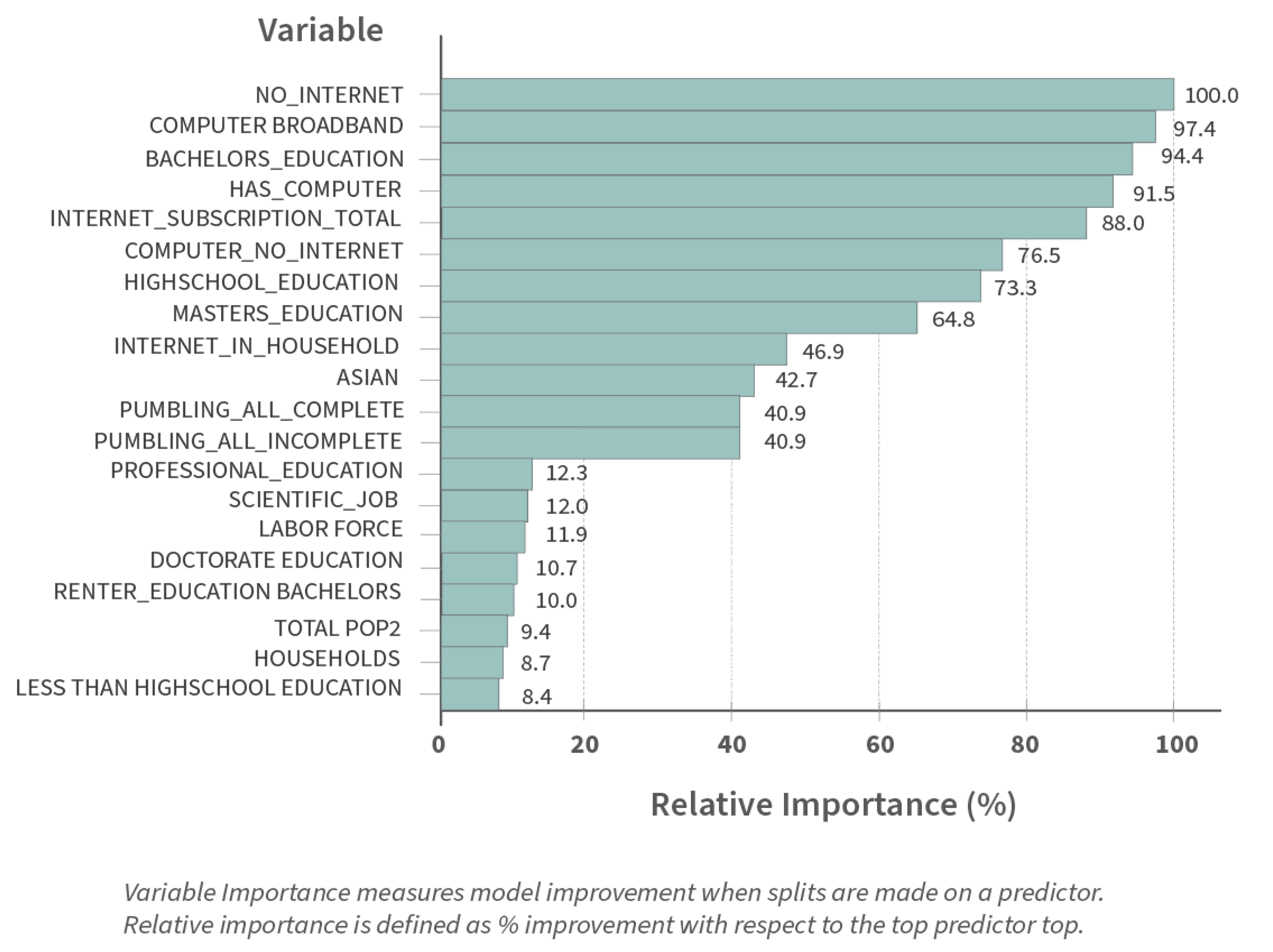
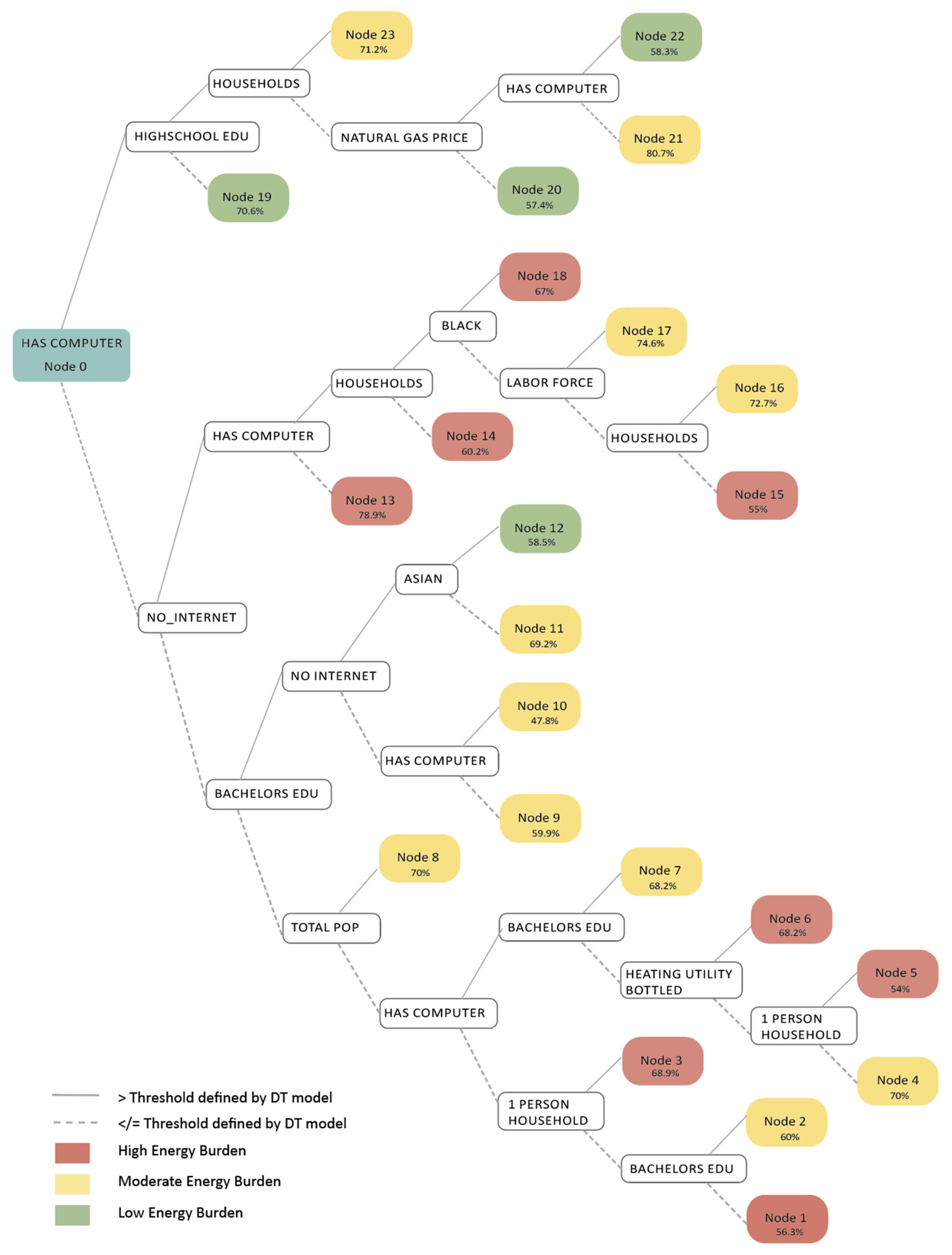
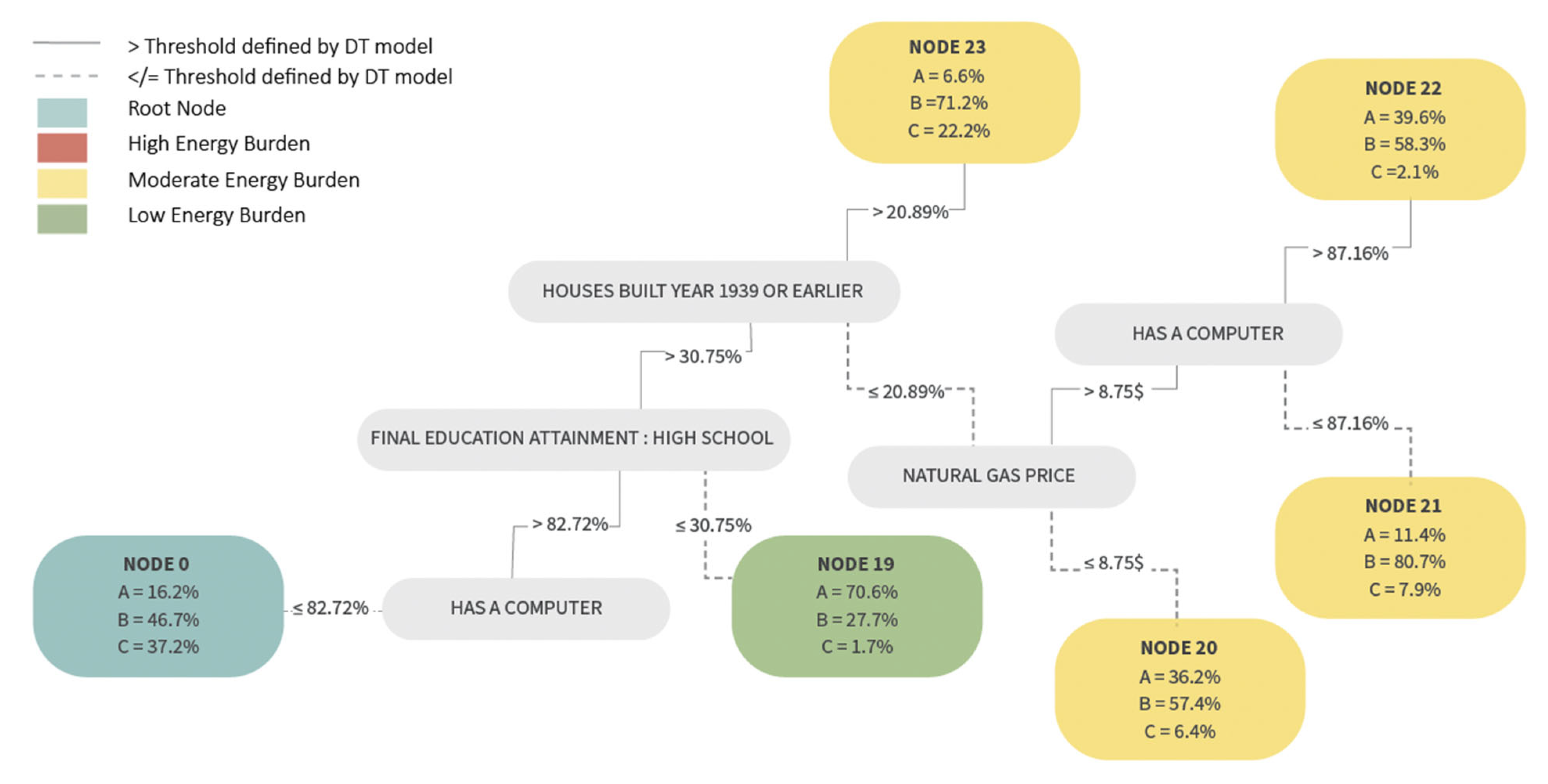

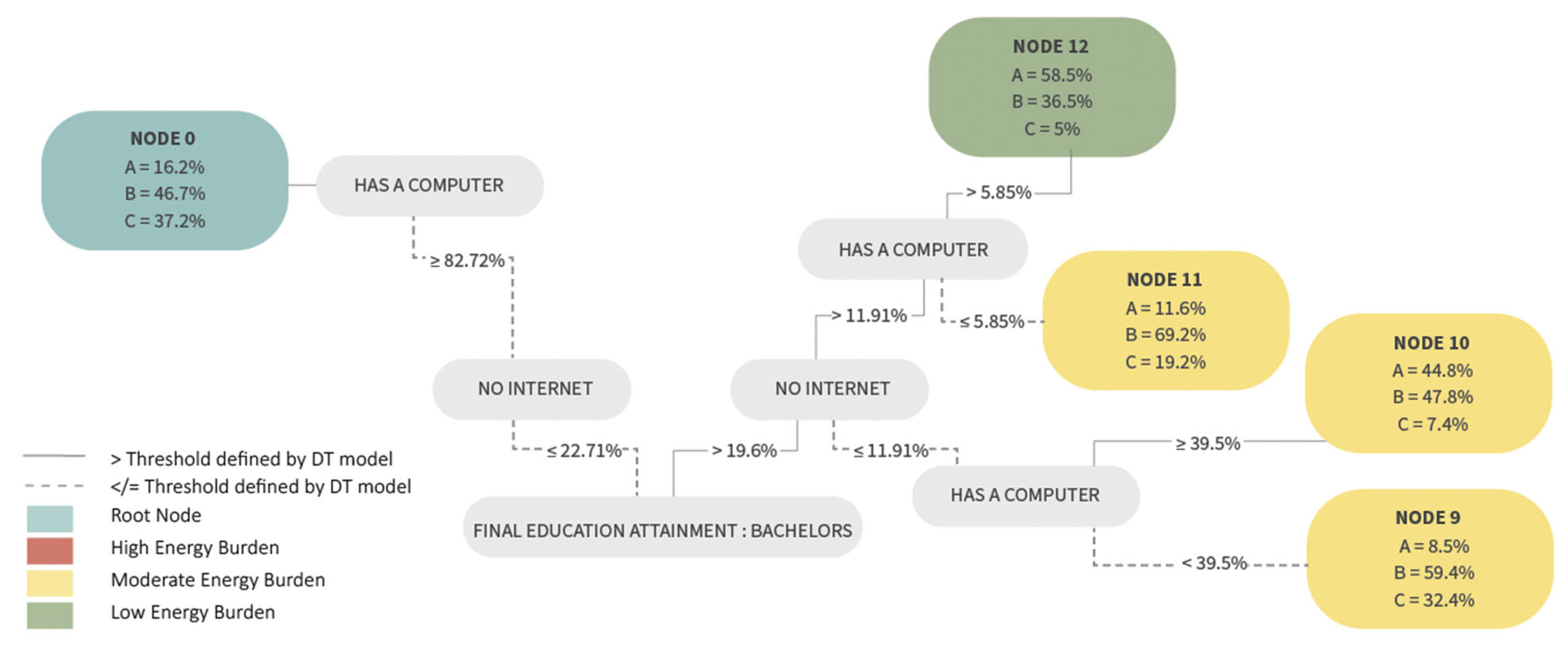
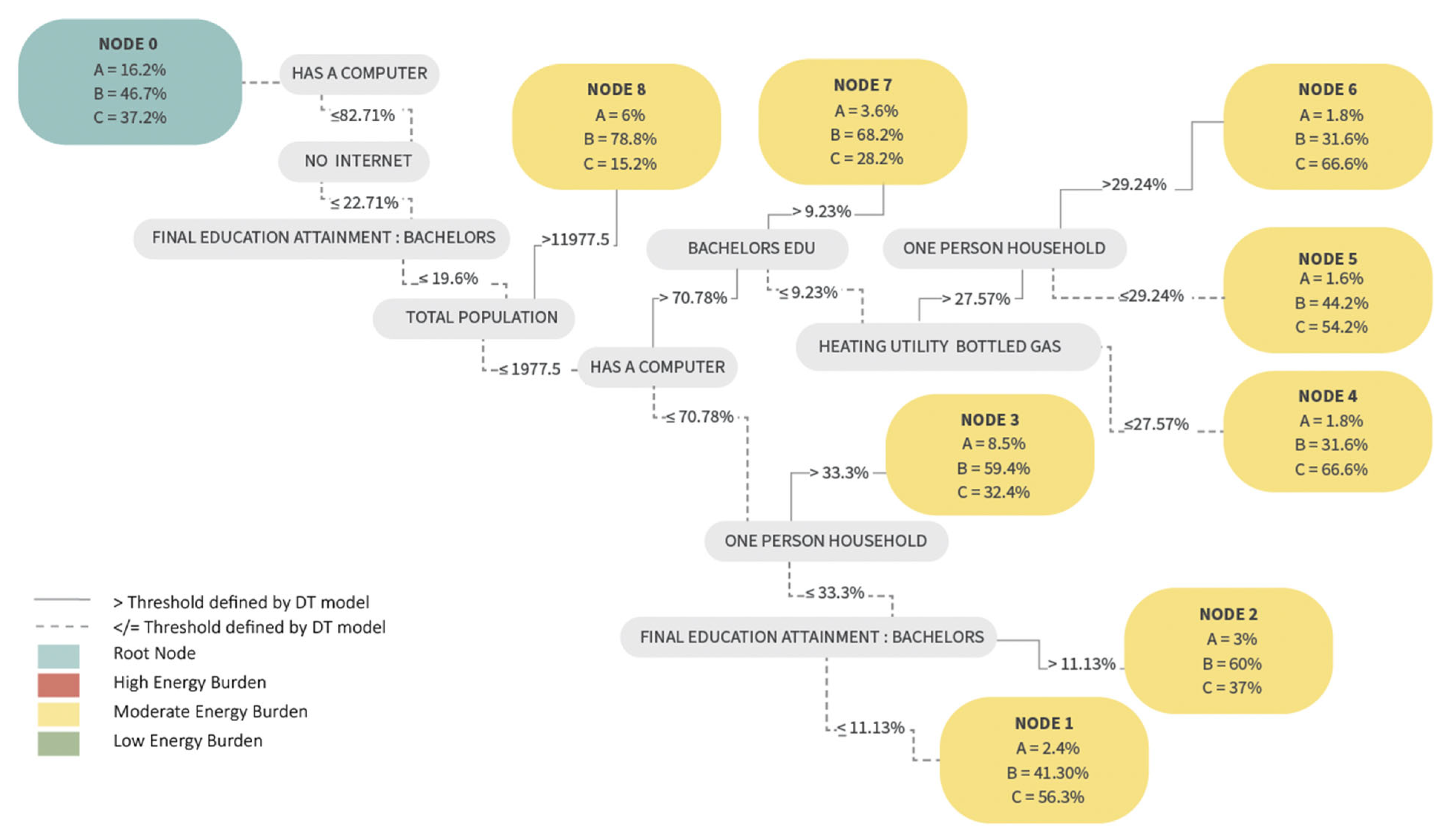

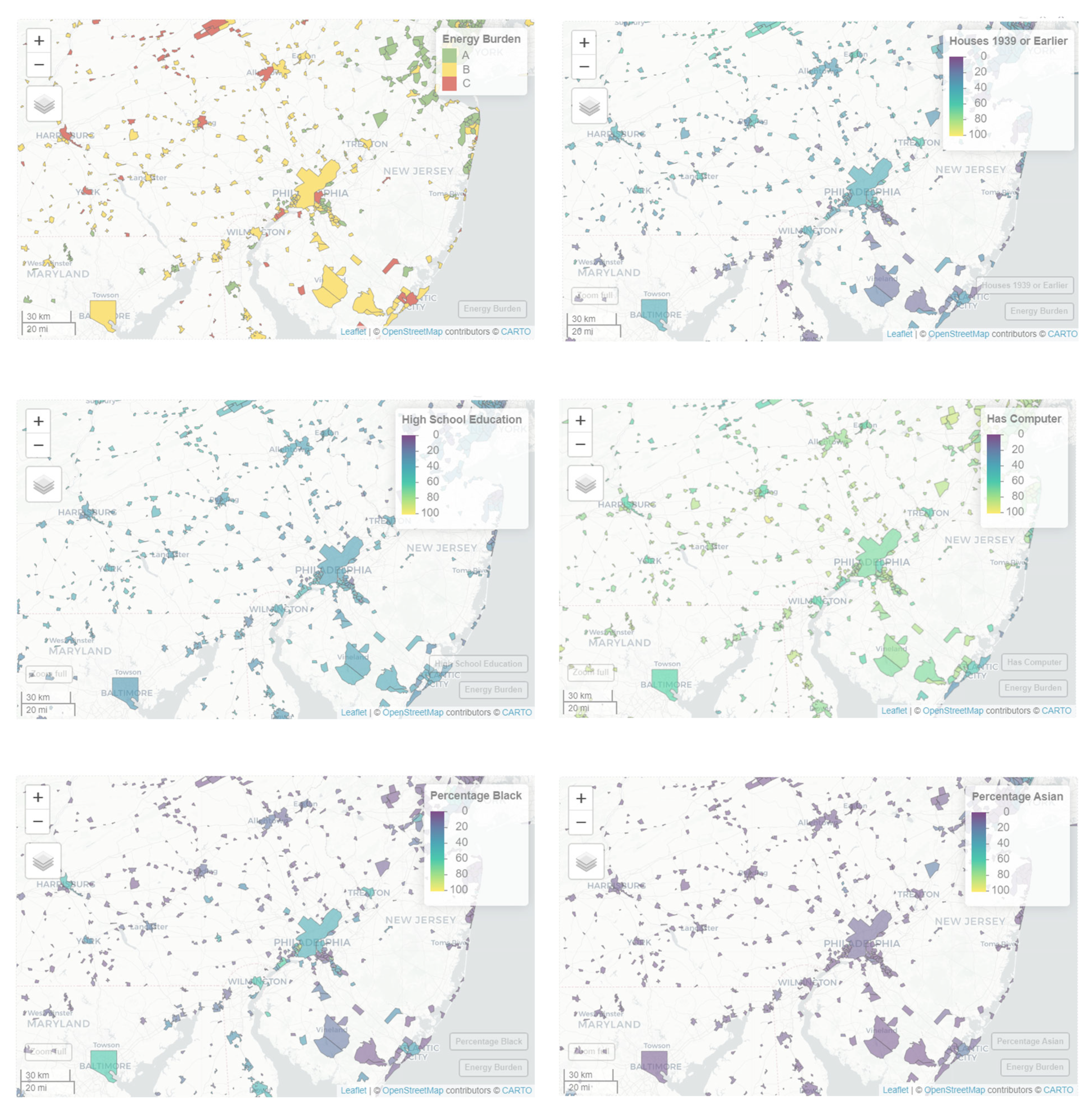
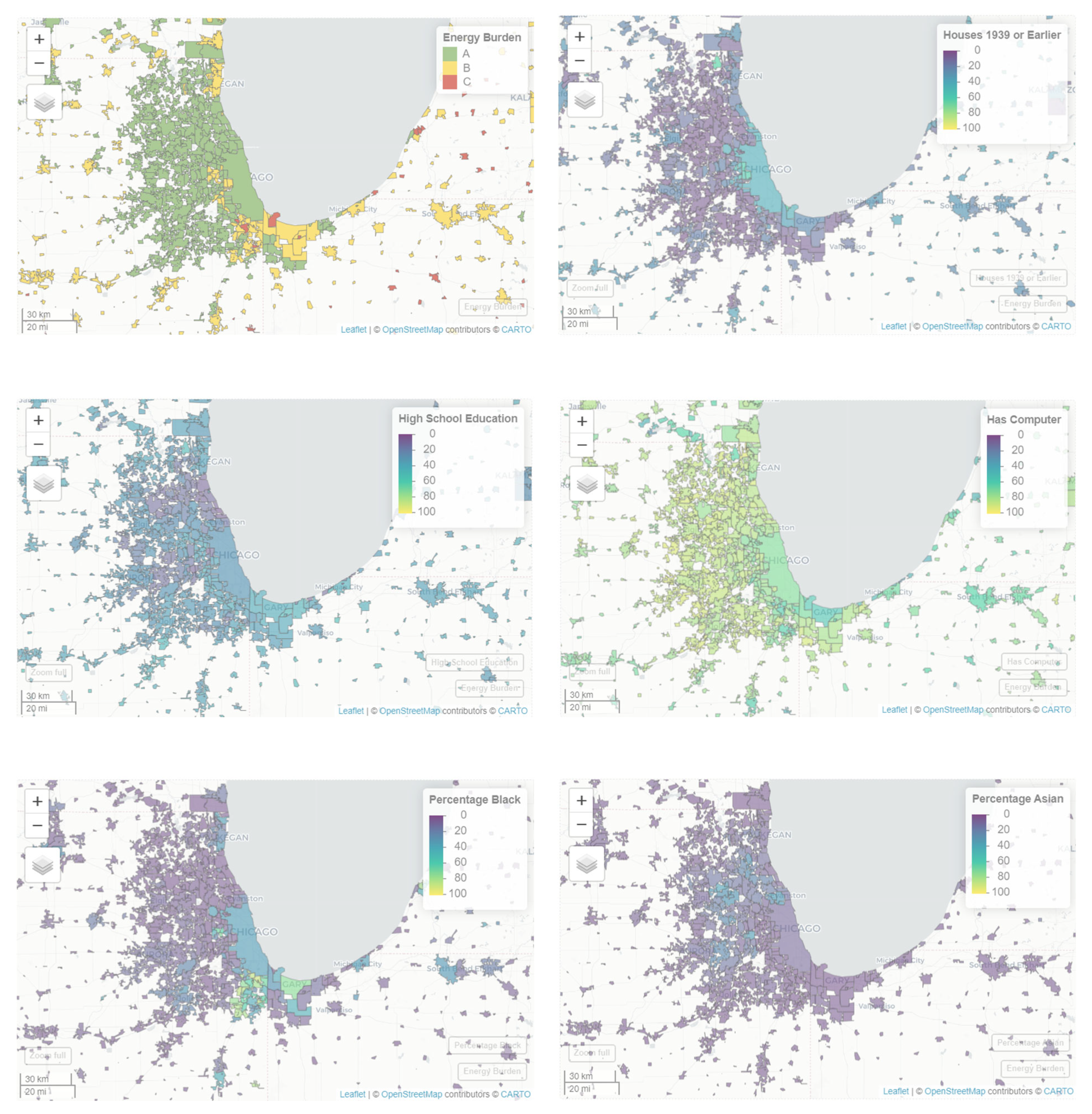
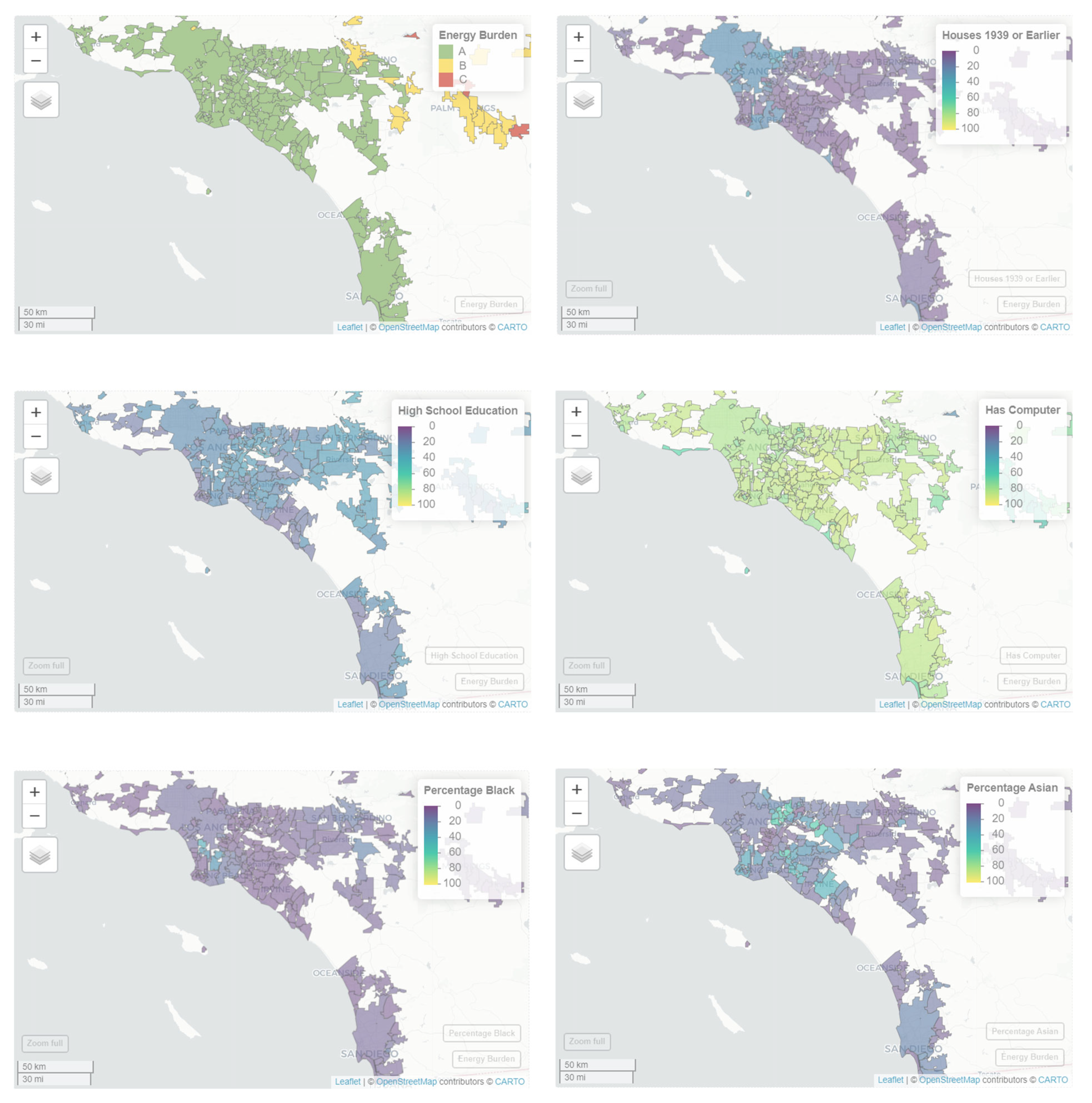
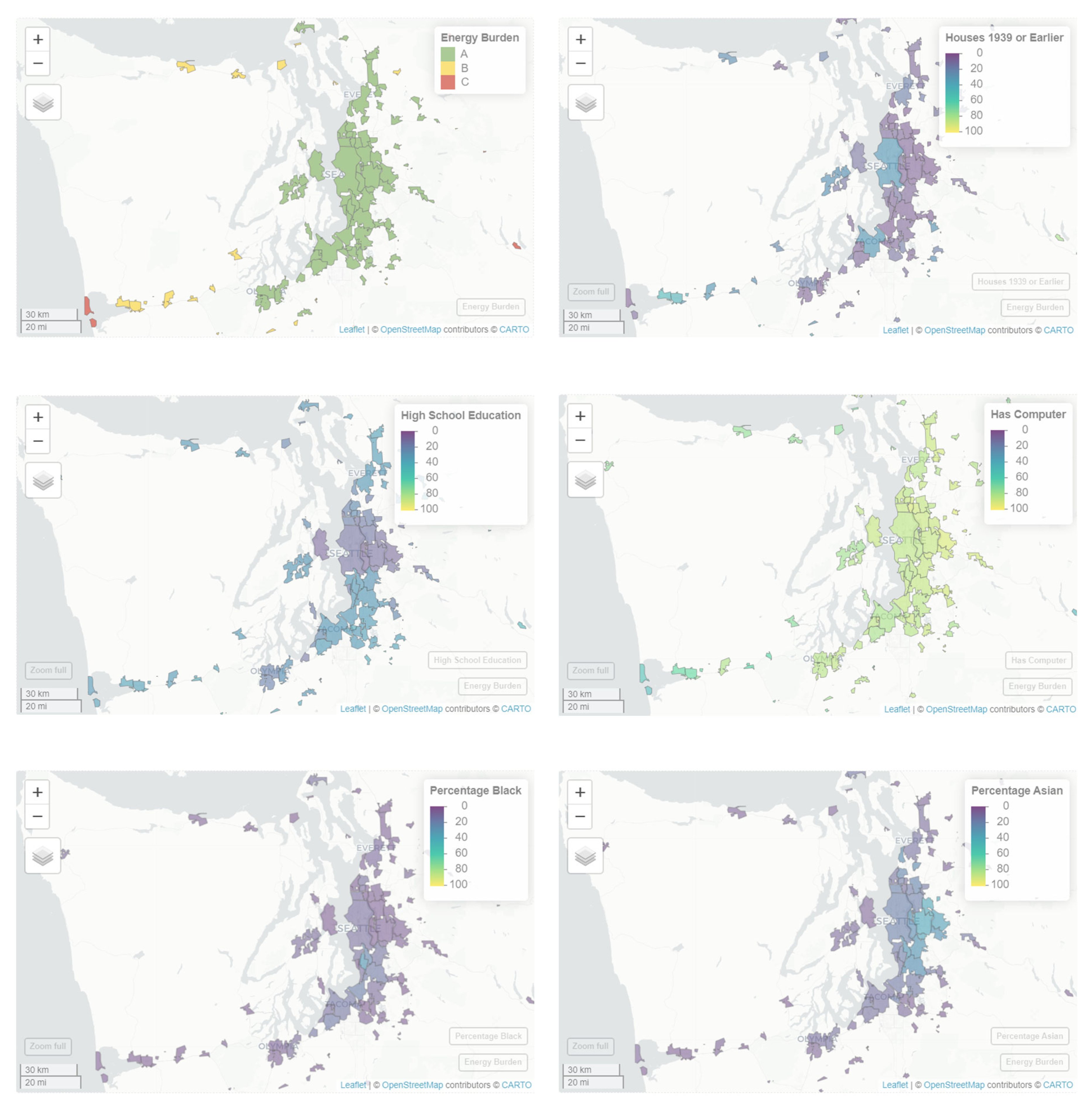
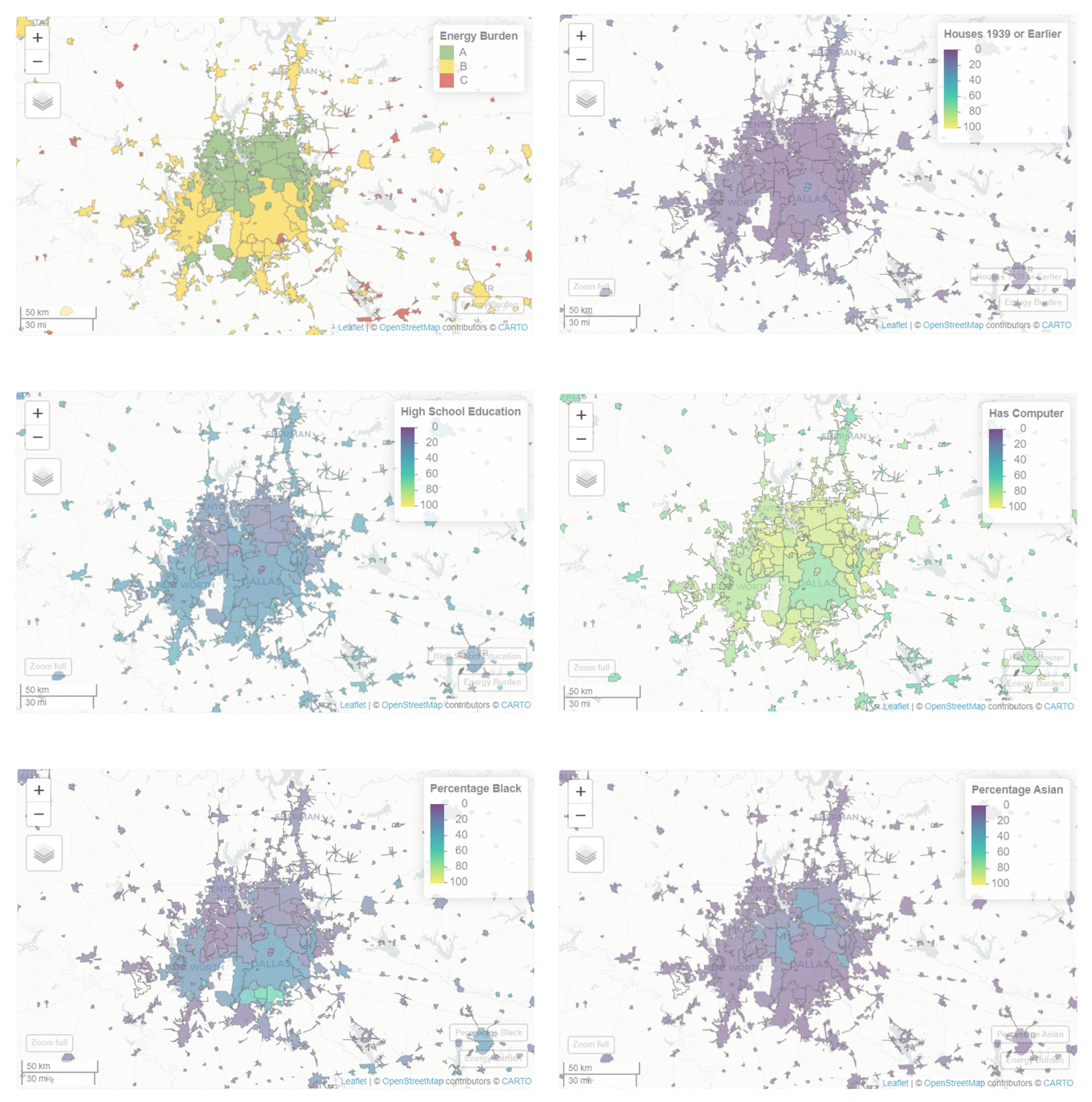
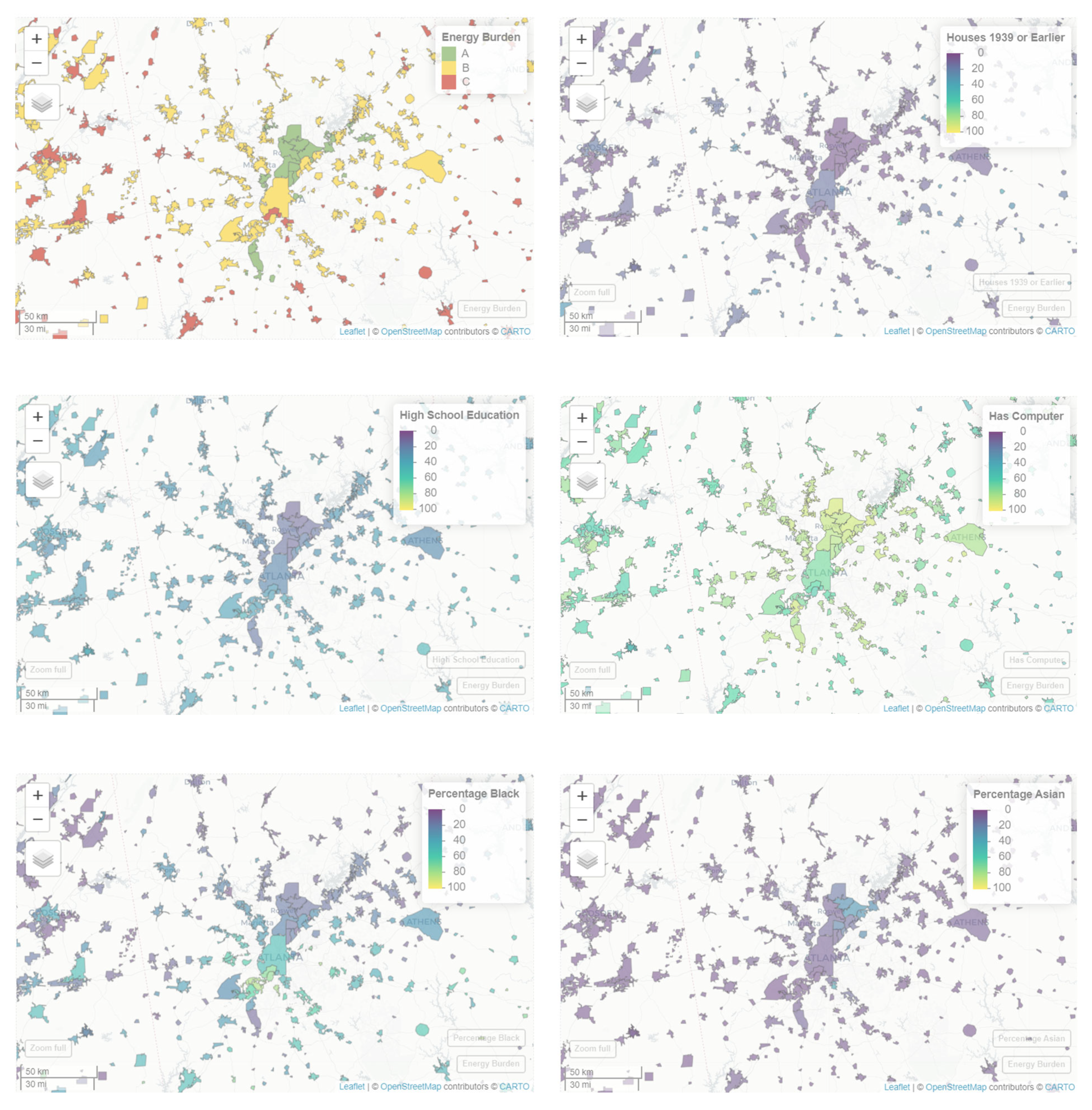
| Reference Variable (Inhabitants) | Raw Variable (Inhabitants) | Transformed Variable (Percentage) |
|---|---|---|
| Total Population | Population over 25 y/o | Population over 25 y/o |
| 2573 | 1870 | 72.68% |
| 1. Demographics | 2. Labor Conditions | 3. Geography | 4. Climate |
| Total Population | Total Workers | Population Density | Median Precipitation |
| Race | Military Population | Area | Median Wind Speed |
| Age | Civilian Population | Land Cover Median | Median Temperature |
| Gender | Labor Force | Land Cover Minimum | |
| Population over 25 | Work industry | Land Cover Maximum | |
| Educational Attainment | |||
| 5. Housing | 6. Housing Utilities | 7. Other Place Characteristics | 8. State Energy Profile |
| Structure Type | Internet type | Housing Age Distribution | Average Electricity Retail Price |
| Number of Rooms | Heating Fuel Type | Commuters | Net Summer Capacity |
| People per Room | Plumbing Status | Renters by Commute Method | Net Generation |
| People per Household | Kitchen Status | Housing Units | Natural Gas Price |
| Vehicles per Renting Household | Telephone Service | Renter Households | |
| Renters per Room | Computer availability | Total Households | |
| Head of Household Education Level | Renter Occupied Housing Units |
| Actual Class—Predicted Class (Training) | Count | A | B | C | Percentage Correct |
| A—Low Energy Burden (less than 4%) | 3038 | 2568 | 395 | 75 | 84.5% |
| B—Medium Energy Burden (between 4 and 6%) | 8765 | 1446 | 5084 | 2235 | 58.0% |
| C—High Energy Burden (more than 6%) | 6983 | 123 | 1551 | 5309 | 76.0% |
| All | 18,786 | 4137 | 7030 | 7619 | 69.0% |
| Actual Class—Predicted Class (Test) | Count | A | B | C | Percentage Correct |
| A—Low Energy Burden (less than 4%) | 3038 | 2485 | 467 | 86 | 81.8% |
| B—Medium Energy Burden (between 4 and 6%) | 8765 | 1318 | 4964 | 2483 | 56.6% |
| C—High Energy Burden (more than 6%) | 6983 | 98 | 1592 | 5293 | 75.8% |
| All | 18,786 | 3901 | 7023 | 7862 | 67.8% |
| Variable | Units | Minimum | Maximum | Mean | Std. Deviation |
|---|---|---|---|---|---|
| NO_INTERNET | % | 0.00 | 100.00 | 20.58 | 12.08 |
| HAS_COMPUTER | % | 0.00 | 100.00 | 72.08 | 15.09 |
| BACHELORS EDU | % | 0.00 | 100.00 | 13.69 | 9.13 |
| TOTAL POP2 | inhabitants | 0 | 8,419,316 | 10,478.18 | 84,505.28 |
| HEATING_UTILITY_BOTTLED | % | 0.00 | 100.00 | 10.57 | 19.06 |
| PERSON_HOUSEHOLD | % | 0.00 | 100.00 | 29.95 | 10.42 |
| HOUSEHOLDS | numbers | 0 | 3,167,034 | 3925.61 | 31,573.02 |
| BLACK | % | 0.00 | 100.00 | 7.97 | 16.99 |
| ASIAN | % | 0.00 | 100.00 | 1.45 | 04.06 |
| LABOR FORCE | % | 0.00 | 396.94 | 70.17 | 15.71 |
| HIGHSCHOOL EDU | % | 0.00 | 100.00 | 35.50 | 12.16 |
| BUILT_1939_EARLIER | % | 0.00 | 100.00 | 21.38 | 18.18 |
| INTERNET_IN_HOUSEHOLD | % | 0.00 | 100.00 | 84.15 | 13.03 |
Disclaimer/Publisher’s Note: The statements, opinions and data contained in all publications are solely those of the individual author(s) and contributor(s) and not of MDPI and/or the editor(s). MDPI and/or the editor(s) disclaim responsibility for any injury to people or property resulting from any ideas, methods, instructions or products referred to in the content. |
© 2025 by the authors. Licensee MDPI, Basel, Switzerland. This article is an open access article distributed under the terms and conditions of the Creative Commons Attribution (CC BY) license (https://creativecommons.org/licenses/by/4.0/).
Share and Cite
Chun, J.; Ortiz, D.; Jin, B.; Kulkarni, N.; Hart, S.; Knox-Hayes, J. Energy Burden in the United States: An Analysis Using Decision Trees. Energies 2025, 18, 646. https://doi.org/10.3390/en18030646
Chun J, Ortiz D, Jin B, Kulkarni N, Hart S, Knox-Hayes J. Energy Burden in the United States: An Analysis Using Decision Trees. Energies. 2025; 18(3):646. https://doi.org/10.3390/en18030646
Chicago/Turabian StyleChun, Jungwoo, Dania Ortiz, Brooke Jin, Nikita Kulkarni, Stephen Hart, and Janelle Knox-Hayes. 2025. "Energy Burden in the United States: An Analysis Using Decision Trees" Energies 18, no. 3: 646. https://doi.org/10.3390/en18030646
APA StyleChun, J., Ortiz, D., Jin, B., Kulkarni, N., Hart, S., & Knox-Hayes, J. (2025). Energy Burden in the United States: An Analysis Using Decision Trees. Energies, 18(3), 646. https://doi.org/10.3390/en18030646






